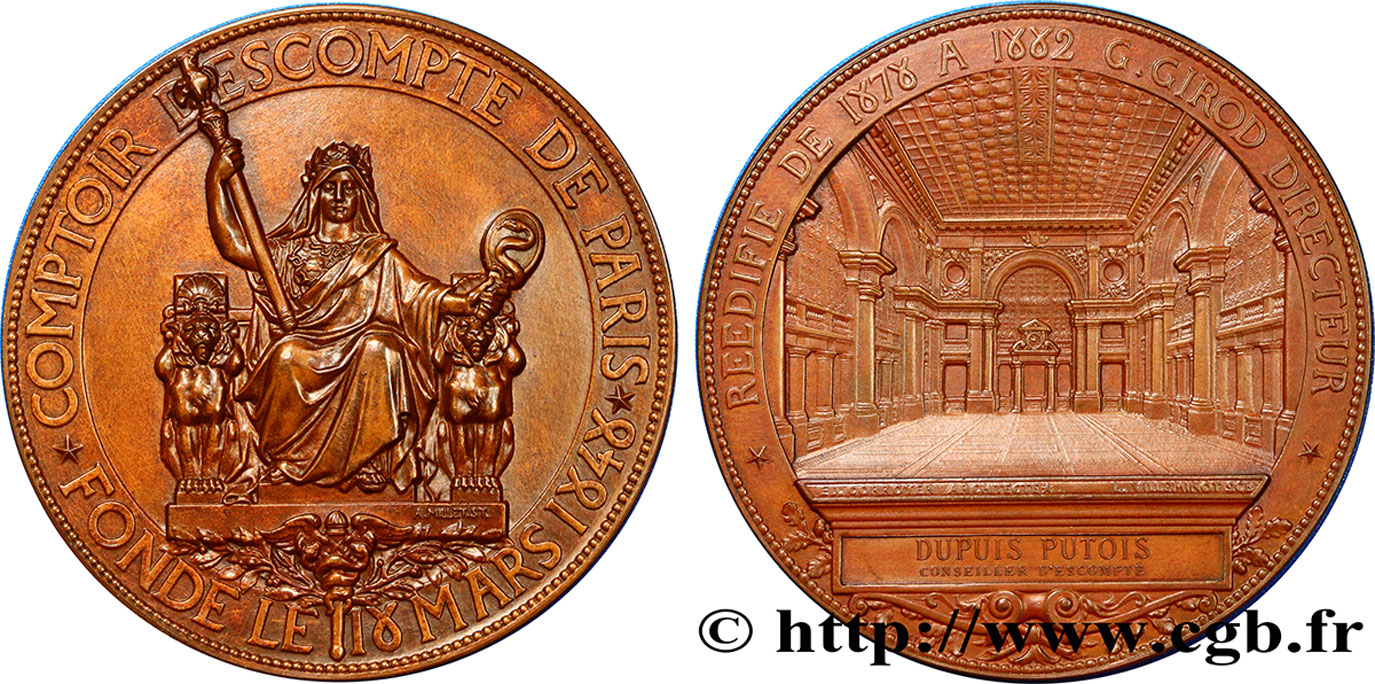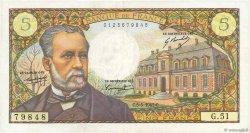- Accueil
- >
- >
fme_400209 - III REPUBLIC Médaille de réédification du comptoir d’escompte
недоступный.
Товар уже продан в нашем интернет-магазине (2018)
Цена: : 450.00 €
Товар уже продан в нашем интернет-магазине (2018)
Цена: : 450.00 €
Тип Médaille de réédification du comptoir d’escompte
Дата: 1882
Монетный двор / Город: 75 - Paris
Металл: bronze
Диаметр: 80,5 mm
Ориентация осей монеты: 12 h.
Гравер TASSET Ernest Paulin (1839-1921)
Вес: 253 g.
Век: lisse + corne BRONZE
Комментарии о состоянии
Magnifique médaille tant par sa conception que par sa conservation. Superbe patine brune
Лицевая сторона
Аверс: легенда: COMPTOIR D’ESCOMPTE DE PARIS / FONDÉ LE 18 MARS 1848.
Аверс: описание: La Prudence qui tient d’une main un sceptre et de l’autre le miroir de la Vérité (grande statue sculptée par Millet).
Обратная сторона
Реверс: легенда: RÉÉDIFIÉE DE 1878 À 1882 - G. GIROD DIRECTEUR // DUPUIS PUTOIS / CONSEILLER D’ESCOMPTE.
Реверс: Описание: Vue en perspective intérieure du bâtiment.
Комментарий
Médaille dans sa boite en cuir rouge et velours bleu, avec au revers sur la base du bâtiment ED. CORROYER ARCHITECTE L. VILLEMINOT SCB.
Ernest Paulin Tasset, connu sous le nom de Paulin Tasset, né à Paris le 15 novembre 1839 et mort en 1921, est un sculpteur, graveur de monnaies et médailleur français. Élève de Eugène-André Oudiné (1810 - 1887), il travaille pour la Monnaie de Paris où il crée de nombreuses médailles et pièces commémoratives. Il grave également de nombreuses pièces de monnaie pour la Bolivie, le Brésil, la Colombie, l'Uruguay, la république dominicaine, la Grèce, la Roumanie, la Serbie, Monaco et le Maroc. Il avait son atelier au 17, rue de Clamart (actuelle rue André-Salel, à Fontenay-aux-Roses, Hauts-de-Seine). (cf. wikipedia)
Le Comptoir national d'escompte de Paris (CNEP) est l'une des quatre banques à l'origine de BNP Paribas. Le Comptoir national d'escompte de Paris (CNEP) est créé par décret le 7 mars 1848, en pleine effervescence révolutionnaire, par le gouvernement provisoire de 1848. Le CNEP est une société au capital social de 20 millions de francs, constitué pour un tiers en numéraire par les associés souscripteurs, pour un tiers en obligations par la Ville de Paris, pour un tiers en bons du Trésor par l'État. En 1853, le CNEP change son nom en Comptoir d'escompte de Paris (CEP).
La croissance est rapide et le capital initial est quadruplé au cours des vingt premières années. En 1860, le CEP ouvre sa première agence étrangère à Shanghai, puis à Calcutta la même année. Dans les années suivantes, de nouveaux bureaux s'installent à l'étranger, comme à Hong Kong, Bombay et Saigon en 1862, à Yokohama en 1867, puis en 1869 à Londres et Alexandrie, ce dernier bureau se trouvant à la tête des agences du Caire (1906) et de Port-Saïd (1909).
L'année 1867 voit également l'ouverture de la première agence provinciale en métropole, à Nantes, qui entretient d'étroites relations avec La Réunion. Viennent ensuite Lyon et Marseille. La même année est créé le Comptoir national d'escompte de Mulhouse au capital d'un million de francs. En 1881, il ouvre deux agences à Melbourne et Sydney pour s'insérer dans le négoce de la laine australienne..
Ernest Paulin Tasset, connu sous le nom de Paulin Tasset, né à Paris le 15 novembre 1839 et mort en 1921, est un sculpteur, graveur de monnaies et médailleur français. Élève de Eugène-André Oudiné (1810 - 1887), il travaille pour la Monnaie de Paris où il crée de nombreuses médailles et pièces commémoratives. Il grave également de nombreuses pièces de monnaie pour la Bolivie, le Brésil, la Colombie, l'Uruguay, la république dominicaine, la Grèce, la Roumanie, la Serbie, Monaco et le Maroc. Il avait son atelier au 17, rue de Clamart (actuelle rue André-Salel, à Fontenay-aux-Roses, Hauts-de-Seine). (cf. wikipedia)
Le Comptoir national d'escompte de Paris (CNEP) est l'une des quatre banques à l'origine de BNP Paribas. Le Comptoir national d'escompte de Paris (CNEP) est créé par décret le 7 mars 1848, en pleine effervescence révolutionnaire, par le gouvernement provisoire de 1848. Le CNEP est une société au capital social de 20 millions de francs, constitué pour un tiers en numéraire par les associés souscripteurs, pour un tiers en obligations par la Ville de Paris, pour un tiers en bons du Trésor par l'État. En 1853, le CNEP change son nom en Comptoir d'escompte de Paris (CEP).
La croissance est rapide et le capital initial est quadruplé au cours des vingt premières années. En 1860, le CEP ouvre sa première agence étrangère à Shanghai, puis à Calcutta la même année. Dans les années suivantes, de nouveaux bureaux s'installent à l'étranger, comme à Hong Kong, Bombay et Saigon en 1862, à Yokohama en 1867, puis en 1869 à Londres et Alexandrie, ce dernier bureau se trouvant à la tête des agences du Caire (1906) et de Port-Saïd (1909).
L'année 1867 voit également l'ouverture de la première agence provinciale en métropole, à Nantes, qui entretient d'étroites relations avec La Réunion. Viennent ensuite Lyon et Marseille. La même année est créé le Comptoir national d'escompte de Mulhouse au capital d'un million de francs. En 1881, il ouvre deux agences à Melbourne et Sydney pour s'insérer dans le négoce de la laine australienne..








 Cообщить об ошибке
Cообщить об ошибке Распечатать страницу
Распечатать страницу Отправить мой выбор
Отправить мой выбор Задать вопрос
Задать вопрос Consign / sell
Consign / sell
 Информация
Информация










